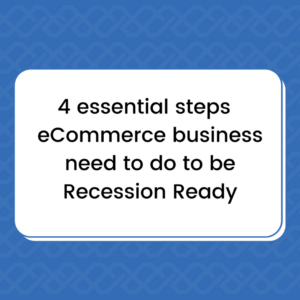In April 2020, I wrote an article titled “Are we heading into a recession?” which included three key points that needed to be met for a recession to take place.
The three stages were:
1- Long Term Supply Chain Disruption
2- Negative Economic Indicators i.e. High Inflation, High Unemployment, and Low Economic growth
3- Survival of / Surge in the Financial Markets
In this article, I go over which conditions we have already met and which are yet to be met; and what this means for eCommerce businesses.
Section 1: Supply Chain Disruptions & How to Respond

As COVID-19 and its effect remain present, this is causing severe disruption to the supply chain. As some economies have returned to operate at pre-COVID capacity while others have not. This is putting further pressure on the supply chain as open economies are looking to offer goods and services as quickly and safely as possible.
With China now struggling with a new strain of COVID-19 (Omicron XE) resulting in the closure of many of its ports. And the rising political situation in Europe. This is adding further pressure on sourcing raw materials and shipping.
The Freightos Global Index, which is a global container index that shows the current average market price of a 40’ container, is at $9,280*, a surge of 7x since the COVID-19 breakout.
With 25 months of COVID-19 and high shipping prices. It is safe to say that this has caused a long-term Supply Chain Disruption. Which meets the first requirement for a recession to take place.
Similarly, to how COVID-19 wasn’t a typical risk event, a recession is not. Therefore, it is crucial for every business to evaluate the risks and challenges. It may arise and how to keep the impacts and probabilities to the minimum.
As a business, there are four key actions to take right NOW which are:
1- Improve Visibility across the chain
2- Improve Flexibility
3- Communicate Effectively with your stakeholders
4- Support your employees mentally and financially so that they remain motivated to work
Section 2: Negative Economic Indicators

AAs described in Section 1, the Freightos Baltic Index has been surging since COVID-19 and raw material prices have also been increasing. This has been further exacerbated by the political situation in Europe. And the outbreak of the new Omicron XE in China. Therefore, inflation has been rising to levels not seen since the 1980s when a severe recession happened.
Inflation has been rising, unemployment levels have been increasing and economic growth has slowed down. All
three measures are key indications of a stagflation i.e. inflation + recession. Yet, another stage has been met for a recession to take place.
Section 3: Survival of/ Surge in the Financial Markets and what’s to come

Since the WHO announced that COVID-19 is a global pandemic, the financial markets plunged by more than 60%. Since then, the markets have been surging and almost all stocks and markets created all-time highs. As discussed in Section 2 of this Article “Negative Economic Indicators”. The inflation levels continue to rise and there will come a time when governments need to impose stricter deflationary measures such as further increasing interest rates to higher levels.
With high-interest rates, people are more inclined to save their money in banks to benefit from the high rewards. It is due to the interest rate resulting in a massive withdrawal from the financial market. Once this happens, markets will no longer be in a survival mode. This will mark the beginning of a recession as all three stages have been met.
Based on the above reasoning, We expect financial markets to survive until May/June 2022. When the US inflation rate hits a double-figure (>10%, currently sitting at 8.6% as of 12th of April, 2022) . This will mark the start of a global recession that will last for at least 12-18 months.

Now that we have explored how the three conditions are met/ yet to be met. It is essential to outline what it means for eCommerce and a few strategies that are essential for survival or even growth in such times.
In a recession, eCommerce businesses like any other businesses will have a dipping revenue and rising costs therefore preparation is key. The following four points will help each and every eCommerce business to create a strategy on how to survive/grow in such times.
1- Get Supply Chain Financing and preserve your capital
Reach out to financing institutions that offer supply chain financing to help you survive and/or grow in a recession.
2- Make Decisions based on data
Start gathering data to understand consumer behavior in different circumstances. This gives the business owner an idea of what products will have a demand during a recession
3- Revise your operating model
Run through your supply chain from start to finish and consider improving on it so that it is cheaper and prone to uncertainty
4- Build an asset-light network
Supply Chain can become difficult in uncertain times and therefore outsourcing to the right partners might offer more flexibility and being more lean.
_______________
* This was the current rate at the time of writing on the 12th of April, 2022. To view the current rate, click here.






